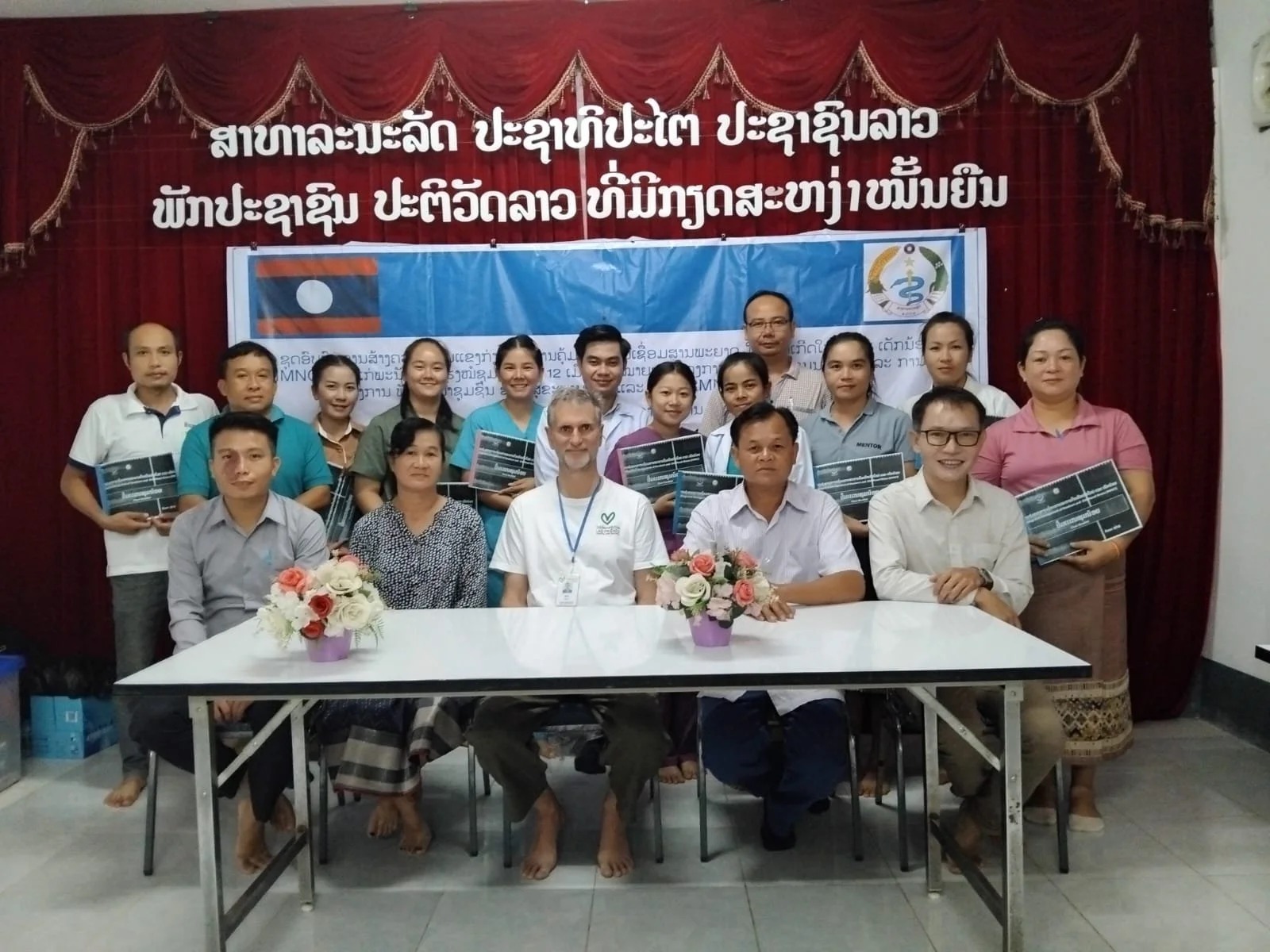LFHC Supports Rural Hospitals to Deliver Better Care and Smarter Referrals
LFHC’s District Hospital Support Program (written by David Vesey, Volunteer Journalist)
A trip to Luang Prabang on the storied Mekong River reveals a stunningly lovely city enveloped by the green mountains of Northern Laos. This beauty, however, hides a rural population confronted by crushing poverty and limited healthcare.
Lao Friends Hospital for Children (LFHC) treats 45,000 children a year at no cost to the family. Any hospital that opens its doors to all patients in a developing country faces monumental challenges in treating every individual who enters its doors. As the only children’s hospital in Northern Laos, LFHC has had to come up with a smart and low-cost solution to try to reduce the often overwhelming flow of children into its facilities and improve the quality of care for children across the province. The goal is to develop a system to treat sick and injured kids with success, but also closer to their own rural homes, many hours from Luang Prabang.
LFHC has rolled out a 3-year programme on a provincial scale to train medical and nursing personnel in 12 surrounding district hospitals on how to better triage, diagnose and treat common childhood illnesses.
In doing so, more children can be treated in district hospitals, rather than facing the difficult and bumpy trip to Luang Prabang. The program was established in 2022 in collaboration with the Luang Prabang Provincial Health Department, and with funding from Child’s Dream, a non-profit organization that supports health and education initiatives for children in the Mekong region.
Gaps in Training and Equipment
Program leaders understand the significant challenge to overcome gaps in training, essential medications, and equipment. “Some districts have no training in emergency care,” said Dr. Phoumy Manivong, the lead LFHC physician in the programme. As examples of district hospital deficiencies, “they don’t have breathing equipment, they don’t have oxygen for patients with respiratory issues. When a patient comes in with a gastric problem and needs fluids, the staff doesn’t have the ability to insert IV lines.”
But one by one, LFHC is sending teams, led by Dr. Phoumy, to the districts to provide advanced support for doctors and nurses, helping them to treat acute malnutrition, respiratory illness, diarrhoea, resuscitation at birth, and other conditions. Thanks to this training, it is hoped that sick children will be able to be cared for in a rural hospital, close to home. That, in turn, will hopefully reduce the overflow of patients at LFHC.
Long-Term Benefits for LFHC
The benefits go beyond the day-to-day care of patients. The project aims to ease the burden in the medium term on the overall, ongoing operations at LFHC. Providing healthcare is a never-ending and demanding test for LFHC, which is 100 percent funded by private donors. The 52-bed hospital constantly needs to attract new funding. It must staff itself with doctors, nurses, additional paediatric specialists, and administrators in order to provide high-quality healthcare to tens of thousands of children every year.
National Healthcare Challenges
Hardships can fall on just about anyone in Laos’ medical environment. District hospitals are run by the government and medical care is not free to patients and families. “Patients have to pay (from USD $2 to $4) for hospital stays, and "some people don’t have the money,” said Dr. Phoumy. That’s a lot of money for a lot of people, especially in Northern Laos. The choice can lead to hard choices such as, ‘we will eat tonight or not eat tonight.’”
On a national level, Laos faces severe economic challenges. Government health initiatives, facing these financial limitations, sincerely try to help Laotians, and have made progress in some areas. Still, Laos has one of the highest under-five mortality rates in Southeast Asia, due largely to newborn complications, diarrhea, and pneumonia. LFHC initiatives, which could be a model for other Laotian hospitals, are helping Laos address some of the world’s worst child and neonatal mortality outcomes.
Building Communication and Confidence
The LFHC District Training Program has developed over time, and four district hospitals received a full package of training and monitoring in 2024, and are scheduled to complete four more in 2025.
Training includes an initial five-day and a second 3-day training package of intensive, face-to-face immersion for clinical staff, with 1 day monitoring visits at the start and end of the programme to assess the impact.
Dr. Neil Simpson, a UK-based paediatrician and LFHC’s long-term volunteer, said, “I want to emphasize the overwhelming sense that staff at district hospitals really appreciate the visits of Dr. Phoumy and training teams. Those taking part in the training are really engaged and really enjoy the training, and get a lot out of it. And they appreciate that people are taking an interest in what otherwise are considered remote places.”
“Dr. Phoumy is incredibly committed and engaged in the programme and does a lot of the training,” said Dr. Simpson. “He liaises with the Provincial Health Department. He is critical on the ground, day to day.”
“By doing the training and monitoring, communication between Luang Prabang and district hospitals is improved”, said Dr. Simpson, who travels multiple times per year to Laos. “The staff get to know each other, the districts are encouraged, and feel more confident to be in contact with Laos Friends Hospital for Children(LFHC). They’ve met Dr. Phoumy and other trainers.”
If possible, in the near future, Dr. Simpson said, “we want to establish tele-medicine” and other forms of ongoing support so that Lao Friends Hospital for Children can provide the best, immediate help for the district hospitals.” He added that it’s difficult to accurately measure the programme’s precise impact on children’s health and well-being due in part to a lack of electronic clinical record systems, but said, “There might be an early indication of an improvement in mortality of children in one district after the programme, but longer-term follow-up is needed.”
Ongoing Challenges for LFHC and District Hospitals
No one says the road ahead is an easy one for the district hospitals, which are funded by the state, or even for LFHC. “At the moment, the hospital is doing good but we still have a lot of challenges,” said Dr. Phoumy. “We don’t have enough doctors and nurses, and sometimes they have to work overtime. We don’t have enough equipment.”
And even though it’s likely that district hospitals will be treating more sick kids locally thanks to the support project, the number of patients at LFHC is increasing. “There are outbreaks of infectious diseases like dengue fever and currently measles, during the year, which means a lot of patients. So we need more donors and sponsors to support our doctors, and to support the whole system,” said Dr. Phoumy.
Increased funding for LFHC, which takes care of children with nowhere else to go, and welcomes every patient at no cost, would enable the hospital to continue investment in training, monitoring, and medical support across the province. It literally would save lives in a country where, even now, one of every 25 children dies before the age of five.








